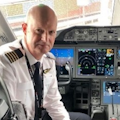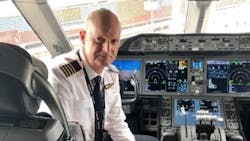The Returning Pilot and The Future of Flight Training
Aviation is amazingly resilient, but the coronavirus epidemic has a had a dramatic effect on the world airline industry. According to the International Civil Aviation Organisation (ICAO), 2021 passenger numbers collapsed by 49% on 2019 figures and the loss of gross passenger operating revenue (estimated actual results) of USD $372 billion1. Prior to the pandemic, Boeing estimated that the world needed 800,000 more pilots in the next 20 years, but a scant six months later, in early 2020, COVID saw approximately half the industry’s pilots grounded and employed elsewhere just to make ends meet.
Despite these grim statistics, the general view is that aviation will bounce back, with estimates suggesting up to 600,000 pilots will be needed and needed quickly. This will present a challenge for flight training organizations around the world, not only having to accommodate the training needs of new pilots but also managing the returning pilot after such a long period without touching the flight controls. The training paths for these two groups will be very different. The world has never experienced a situation where so many pilots are “uncurrent” and need to be re-introduced to the flight deck. How do you manage and retrain such a large cohort of “uncurrent” pilots? What training will be needed? Will certain skills be degraded more than others? How quickly can these pilots be returned to operational status while ensuring regulatory and airline standards are met?
These are the questions that Australia’s national carrier, Qantas Airways, has been asking with the view of providing the best, most efficient and targeted training possible to not only meet the standards required but to support the pilots on their return. Prior to COVID 19, Qantas took an innovative and courageous step and fitted a Seeing Machines eye tracker to its new Boeing 787 simulator to investigate how to use this technology in flight training by examining pilot eye scan behavior. The fitting of the eye tracker was courageous because this technology is capable of accurately tracking a pilot’s eyes but understanding what the eye position means and the full extent of how the technology can be used in training, has yet to be determined.
Interest in eye tracking has been around for at least 100 years, but most experiments have been confined to the laboratory using relatively small data sets. Qantas is taking a long-range view of the possibilities eye tracking offers by undertaking a number of trials using real world data to investigate how this technology could be more broadly deployed. A key focus area is the returning pilot and their eye scan behavior.
A critically important skill that a pilot must master is the instrument scan. An instrument scan is the structured and sequential movement of the eyes over the flight instruments designed to gather relevant and timely information about the aircraft’s current and future state. The pilot’s ability to scan flight instruments effectively is tightly coupled to performance and is considered to be a critical skill that pilots must attain in order to fly an aircraft competently. Pilots acquire most of their information visually using a scan that is cognitively complex in visuomotor applications and developing efficient scans requires training and experience to perfect. There is still more research required to fully understand scan behavior and one area that Qantas is interested in is the effect such a long period away from the flight deck has on scan performance and to what degree is scan a perishable commodity? How might this guide training efforts? One study Qantas will engage in is using the eye tracker on the Boeing 787 simulator to track the gaze and attention of returning pilots to determine what changes in scan patterns might be revealed and what changes in scan strategy or performance may be indicated over the course of retraining. It remains unclear about the resilience or fragility of scans or the speed at which an experienced pilot can reacquire a scan during training in the simulator. Tracking the eye movement and more importantly, understanding the eye movement data, may influence training and provide benefits that are yet to be revealed and exploited.
This trial is one of a number of trials and studies already conducted and being planned by Qantas to obtain answers about eye tracking, and how they could be used in the real world of airline flight training. It is uncharted territory and much work needs to be done with an increasing number of tantalizing questions arising out of the work that has already been completed. The work being undertaken by Qantas in eye tracking and scanning is aimed at determining how to use this technology and the unique combination of the Qantas 787 simulator and the Seeing Machines eye tracker is well placed as a test bed to conduct a number of innovative projects.
New technology always comes with a number of questions, particularly technology that needs extensive research to be understood. As American businessman Nolan Bushnell stated, “Innovation is hard. It really is. Remember the automobile, the airplane, the telephone, these were all considered toys at their introduction because they had no constituency. They were too new.” Recognition of how to deploy aircraft, now so commonplace and a vital part of the global economy, had a slow birth with French General Ferdinand Foch dismissing aircraft as interesting toys having no military value. Time, investigation, using a well-designed and balanced research methodology are the ingredients that will be needed in unlocking what eye trackers may reveal. The potential consequences of this technology may bring dividends that may herald a new era in how we train pilots.
Innovative use of eye tracking technology and understanding the complex nature of pilot scans and data, has implications for the future of flight training. The full flight simulator is a cornerstone of flight training around the world and the next step may be the combination of eye trackers and simulators becoming common place if this combination is to be understood more completely. Shorter and better training paths or enhanced diagnostic capabilities in student performance may be the result. Eye trackers may even find their way onto aircraft flight decks and become part of a systems approach to training and safety using blended data from a number of different sources. This is all in the future and beyond the current horizon but the work Qantas is now doing will assist in determining what this future looks like and helps to answer the question of what information the eye tracker is telling us and how it can be best put to use to support the “human in the loop.”
References
1. CAO, Effects of Novel Coronavirus (COVID 19) on Civil Aviation: Economic Impact Analysis, 18 January 2022.
About the Author

Matt Gray
Matt trained as a pilot and instructor in the RAAF and spent 32 years in Qantas flying the Boeing 747 and flying and examining on the B767, B737 and B787. Matt was a management pilot for 20 years finishing as the Head of Training and Checking where he introduced an eye tracker on the B787 simulator. Matt holds a Master of Aviation and is currently doing a PhD in pilot eye scan behavior.
